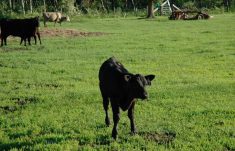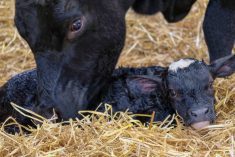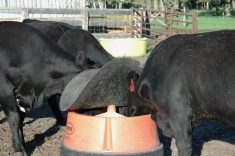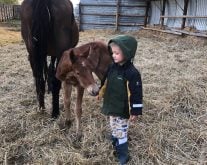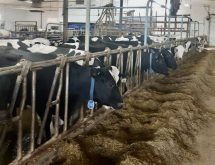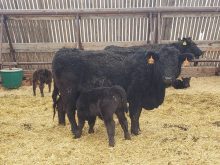This fall I visited three similar dairies milking between 100 and 150 cows. It was about 10 a.m. in two barns (different days) and midafternoon in the third. In each case I noticed less than 10 per cent of resting cows (three-quarters were lying down) were not chewing their cud. I reviewed the TMR in each feed bunk and the associated forage analysis. All three dairies were feeding highly digestible corn silage and third-cut alfalfa, with no visible source of long-stem forage.
My takeaway thought was that not enough effective forage fibre was being fed in all three. However, that was quickly contradicted by a few weeks of high milkfat records in good milk volume shipments in each case. Despite my initial bewilderment, in hindsight I still maintain there was a lack of effective forage fibre in these lactation diets. That type of feed will not sustain good long-term performance on these or any other dairy farm.
Read Also

Harvest wraps up and fall work begins
At the Eppich famly ranch in western Saskatchewan, the fall harvest was successful with few breakdowns, cows and calves have been sorted and a new tractor has arrived
One of the pillars of dairy lactation science is that effective forage fibre is not a true nutrient like energy and protein, but there is a strict requirement for it in the lactating dairy cow’s diet. It stimulates nerves in their inner rumen wall into regurgitating the dairy diet back into the cow’s mouth.
In turn, she chews large forage particles into smaller pieces and swallows them again. Cud chewing not only aids the dietary fermentation process by the ruminal microbes, but repeats itself until large forage particles are either digested in the rumen or become small enough (10-11 mm) to leave the rumen and enter the omasum and later the abomasum.
For example, about 50 to 60 per cent of milkfat structure is built from such ruminal volatile fatty acids and other metabolites. They are generated by rumen-microbial fermentation of effective forage fibre. The other 50 per cent milkfat portion is drawn off from fatty acids absorbed directly from the bloodstream. It is here where added palm fat bypasses the rumen and become a direct support of milkfat levels.
Three rules for fibre
I use three mainstream “effective fibre” rules to assure cows remain healthy by properly chewing their cud:
- The diet contains 28 per cent NDF.
- 75 per cent of this NDF comes from forage or equivalent sources (21-22 per cent eNDF)
- Forages are chopped to provide 15-20 per cent of the dietary particles being more than 1.5 inches long, creating a good floating mat in the rumen.
As I ponder the significance of these three effective fibre rules in all lactating dairy diets, I cannot help wonder how the above dairies seemingly circumvent them. Another group of three producers that feed similar lactation diets may offer plausible explanations:
- Producer No. 1 keeps non-fibre-carbohydrate levels well below 38 per cent of the total lactation diet (dm basis). A couple of years ago, he fed highly digestible corn silage with 33 per cent starch levels. At least 1.5 kg of grain corn per cow was removed in the associated grain mix.
- Producer No. 2 feeds highly digestible corn silage and about eight pounds of alfalfa hay per head, decreased from 12 pounds in a previous diet. He also quit adding three to four pounds of brome grass hay because extra hay led to uncontrollable sorting, which was followed by sub-clinical acidosis (SARA) in the lactating herd.
- Producer No. 3 told me that he watches the daily manure from all his milk cows. If it’s getting a little loose (a sign of SARA), he increases the alfalfa-grass portions by about one kilogram and removes about three kilograms of high-quality corn silage.
As a footnote, all these producers, and the former dairies, feed palm fat at 500 grams per head per day. It seems on each farm that adding this amount of palm fat leads to a 0.2-0.4 per cent increase response in milkfat, regardless of in-diet effective forage fibre levels.
Not to diminish the value of palm fat in lactating dairy diets, but whenever I visit these latter three producers, most of their resting lactating cows are rhythmically belching and chewing without a care in the world. Therefore, I’m confident that dietary fibre levels in each of these dairy diets are adequate for good long-term milk/milkfat production. It also makes me think a more concrete investigation is needed into the lack of cud-chewing cows in the first group of dairies.




